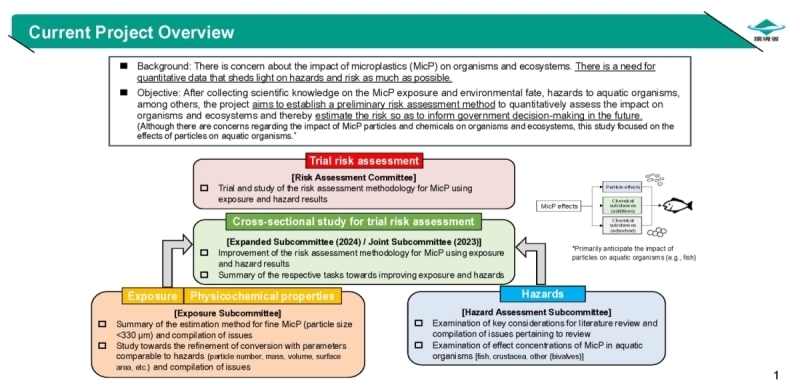Microplastics Risk Assessment Methodology for Aquatic Organisms
Ecosystem Impact Assessment and Trend Survey on Microplastics
Project Overview
It is estimated that over millions of tons of plastics litter go into the marine environment annually worldwide. Therefore, concerns about the impacts of marine plastics litter, including microplastics*, on the organisms and ecosystems as well as the negative effects of marine plastic pollution on the living environment, fisheries, tourisms and other sectors are growing. This issue is being discussed as a critical and urgent challenge at various international conferences such as United Nations conferences.
For understanding the impact of microplasitcs on organisms and ecosystems, consideration is needed for microplastic particles themselves as well as the additives and absorbed chemicals. Furthermore, there are various steps and challenges to conduct a quantitative risk assessment of these impacts: determining the density/distribution and environmental fate of microplastics and associated chemicals (exposure data); conducting quantitative evaluation of the hazard data with the reliability assessments; and finally conducting risk assessment based on the exposure and hazard data.
After collecting scientific knowledge on the microplastic exposure and environmental fate, hazards to aquatic organisms, among others, the project, with experts in related fields, aims to establish a preliminary risk assessment method to quantitatively assess the impact on organisms and ecosystems and thereby estimate the risk so as to inform government decision-making in the future. Although there are concerns regarding the impact of microplastic particles and chemicals on organisms and ecosystems, this study focused on the effects of particles on aquatic organisms.
* It is referred to as "MicP" in the documents below.

Project Overview of FY2024
For understanding the impact of microplasitcs on organisms and ecosystems, consideration is needed for microplastic particles themselves as well as the additives and absorbed chemicals. Furthermore, there are various steps and challenges to conduct a quantitative risk assessment of these impacts: determining the density/distribution and environmental fate of microplastics and associated chemicals (exposure data); conducting quantitative evaluation of the hazard data with the reliability assessments; and finally conducting risk assessment based on the exposure and hazard data.
After collecting scientific knowledge on the microplastic exposure and environmental fate, hazards to aquatic organisms, among others, the project, with experts in related fields, aims to establish a preliminary risk assessment method to quantitatively assess the impact on organisms and ecosystems and thereby estimate the risk so as to inform government decision-making in the future. Although there are concerns regarding the impact of microplastic particles and chemicals on organisms and ecosystems, this study focused on the effects of particles on aquatic organisms.
* It is referred to as "MicP" in the documents below.

Project Overview of FY2024